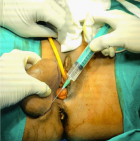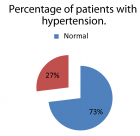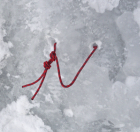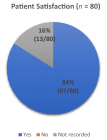Abstract
Review Article
Relation of Arachnophobia with ABO blood group system
Muhammad Imran Qadir and Sani E Zahra*
Published: 08 August, 2019 | Volume 3 - Issue 1 | Pages: 050-052
In 1901, ABO system of blood groups was determined by Karl Landsteiner. It is present in different organisms like rodents, primates that includes chimpanzees, bonobos etc. The blood groups type in this system depends on some genes that are specific ABO gene. Arachnophobia is the dread of creepy crawlies and different creature like spiders. Individuals suffering from arachnophobia generally feels uneasy in any place where they accept that they could harbour arachnids or their existence for example, webs. 100 samples of blood from volunteers were used for Blood group test. The Blood groups were tested and results were recorded after the test all the used kits were discarded. The results shows that there is no clear cut difference between the arachnophobic males and non-arachnophobic male’s percentages, so no relation found in males. Similarly, in females both phobic and non-phobic ladies have no differences in their result values so, no relation was found. Whereas, in case of arachnophobic males and females comparison no relation was found. So, there is no relationship between ABO blood group system and arachnophobia and there may be a relation between non-phobia and AB+, B+ blood group in males whereas, in females only B+ blood group have relation with non-phobia.
Read Full Article HTML DOI: 10.29328/journal.jhcr.1001011 Cite this Article Read Full Article PDF
Keywords:
Blood samples; Arachnophobia; Blood analysis
References
- Watkins W. The ABO blood group system: historical background. Transfusion medicine. 2001; 11: 243-265. PubMed: https://www.ncbi.nlm.nih.gov/pubmed/11532183
- Hassawi DS. Allele frequency and molecular genotypes of ABO blood group system in a Jordanian population. J Med Sci. 2007; 7: 51-58.
- Granado LC, Ranvaud RP Jr. A spiderless arachnophobia therapy: comparison between placebo and treatment groups and six-month follow-up study. Neural plasticity. 2007. PubMed: https://www.ncbi.nlm.nih.gov/pubmed/17713595
- Bouchard S, Côté S, St-Jacques J, Robillard G, Renaud P. Effectiveness of virtual reality exposure in the treatment of arachnophobia using 3D games. Technology and health care. 2006; 14: 19-27. PubMed: https://www.ncbi.nlm.nih.gov/pubmed/16556961
- Ogasawara K, Yabe R, Uchikawa M, Saitou N, Bannai M, et al. Molecular genetic analysis of variant phenotypes of the ABO blood group system. Blood. 1996; 88: 2732-2737. PubMed: https://www.ncbi.nlm.nih.gov/pubmed/8839869
- Al-Arrayed S, Shome DK, Hafadh N, Amin S, Al Mukhareq H, et al. ABO blood group and Rhd phenotypes in Bahrain: Results of screening school children and blood donors. Bahrain Med Bull. 2001; 23: 112-115.
- Levine DM, Green LW, Deeds SG, Chwalow J, Russell RP, et al. Health education for hypertensive patients. Jama. 1979; 241: 1700-1703. PubMed: https://www.ncbi.nlm.nih.gov/pubmed/430732
Figures:

Figure 1

Figure 2

Figure 3
Similar Articles
-
Relation of Arachnophobia with ABO blood group systemMuhammad Imran Qadir,Sani E Zahra*. Relation of Arachnophobia with ABO blood group system. . 2019 doi: 10.29328/journal.jhcr.1001011; 3: 050-052
Recently Viewed
-
A Study on Incidence, Risk Factors, and Maternal Outcome of Placenta Accreta Spectrum in a Tertiary Care HospitalMittapalli Jyothirmayee**. A Study on Incidence, Risk Factors, and Maternal Outcome of Placenta Accreta Spectrum in a Tertiary Care Hospital. Clin J Obstet Gynecol. 2025: doi: 10.29328/journal.cjog.1001191; 8: 074-00
-
Breast Imaging Services Utilization Trends Across Private and Government-Insured Patients in a National Radiology PracticeAndrew K Hillman*,Phil Ramis,Patrick Nielsen,Sophia N Swanston,Dana Bonaminio,Eric M Rohren. Breast Imaging Services Utilization Trends Across Private and Government-Insured Patients in a National Radiology Practice. J Clin Med Exp Images. 2025: doi: 10.29328/journal.jcmei.1001037; 9: 020-027
-
A Rare Consanguineous Case of Alazami Syndrome in a Jordanian Family: Clinical Presentation, Genetic Analysis, and Therapeutic Approaches - A Case ReportFawzi Irshaid*, Salim Alawneh, Qasim Al Souhail, Aisha Alshdefat, Bashar Irshaid, Ahmed Irshaid. A Rare Consanguineous Case of Alazami Syndrome in a Jordanian Family: Clinical Presentation, Genetic Analysis, and Therapeutic Approaches - A Case Report. J Clin Med Exp Images. 2024: doi: 10.29328/journal.jcmei.1001031; 8: 003-006
-
Fiesta vs. Stress Condition the Incidence and the Age at Menarche. Forty Years of ResearchCarlos Y Valenzuela*. Fiesta vs. Stress Condition the Incidence and the Age at Menarche. Forty Years of Research. Clin J Obstet Gynecol. 2025: doi: 10.29328/journal.cjog.1001190; 8: 069-073
-
The Outcome of Patients with Leukemia Presenting with Hyperleukocytosis Requiring Leukapheresis. The Experience of King Fahad Specialist Hospital in Dammam, Saudi ArabiaKhalid Ahmed Al-Anazi*, Alsaffar WA, Aljishi FK, Kanfer S, Kalogiannidis P, Alenazi W, Alshammasi Z, Albahrani A, Abduljalil O, Mutahar E, Alwakeel AM, Apostolidis I, Darweesh M, Almokhtar N, Abdulbaqi M, Albanyan O, Alshaibani Z, Raslan H, Aldayel A. The Outcome of Patients with Leukemia Presenting with Hyperleukocytosis Requiring Leukapheresis. The Experience of King Fahad Specialist Hospital in Dammam, Saudi Arabia. J Hematol Clin Res. 2024: doi: 10.29328/journal.jhcr.1001028; 8: 008-016
Most Viewed
-
Feasibility study of magnetic sensing for detecting single-neuron action potentialsDenis Tonini,Kai Wu,Renata Saha,Jian-Ping Wang*. Feasibility study of magnetic sensing for detecting single-neuron action potentials. Ann Biomed Sci Eng. 2022 doi: 10.29328/journal.abse.1001018; 6: 019-029
-
Evaluation of In vitro and Ex vivo Models for Studying the Effectiveness of Vaginal Drug Systems in Controlling Microbe Infections: A Systematic ReviewMohammad Hossein Karami*, Majid Abdouss*, Mandana Karami. Evaluation of In vitro and Ex vivo Models for Studying the Effectiveness of Vaginal Drug Systems in Controlling Microbe Infections: A Systematic Review. Clin J Obstet Gynecol. 2023 doi: 10.29328/journal.cjog.1001151; 6: 201-215
-
Causal Link between Human Blood Metabolites and Asthma: An Investigation Using Mendelian RandomizationYong-Qing Zhu, Xiao-Yan Meng, Jing-Hua Yang*. Causal Link between Human Blood Metabolites and Asthma: An Investigation Using Mendelian Randomization. Arch Asthma Allergy Immunol. 2023 doi: 10.29328/journal.aaai.1001032; 7: 012-022
-
Impact of Latex Sensitization on Asthma and Rhinitis Progression: A Study at Abidjan-Cocody University Hospital - Côte d’Ivoire (Progression of Asthma and Rhinitis related to Latex Sensitization)Dasse Sery Romuald*, KL Siransy, N Koffi, RO Yeboah, EK Nguessan, HA Adou, VP Goran-Kouacou, AU Assi, JY Seri, S Moussa, D Oura, CL Memel, H Koya, E Atoukoula. Impact of Latex Sensitization on Asthma and Rhinitis Progression: A Study at Abidjan-Cocody University Hospital - Côte d’Ivoire (Progression of Asthma and Rhinitis related to Latex Sensitization). Arch Asthma Allergy Immunol. 2024 doi: 10.29328/journal.aaai.1001035; 8: 007-012
-
An algorithm to safely manage oral food challenge in an office-based setting for children with multiple food allergiesNathalie Cottel,Aïcha Dieme,Véronique Orcel,Yannick Chantran,Mélisande Bourgoin-Heck,Jocelyne Just. An algorithm to safely manage oral food challenge in an office-based setting for children with multiple food allergies. Arch Asthma Allergy Immunol. 2021 doi: 10.29328/journal.aaai.1001027; 5: 030-037

If you are already a member of our network and need to keep track of any developments regarding a question you have already submitted, click "take me to my Query."



















































































































































